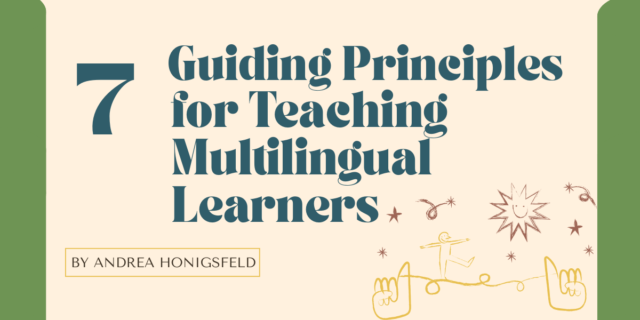
The following is an adapted excerpt from Lindsey Moses’ Supporting Multilingual Learners, available now!
What are Scaffolds?
Most educators are familiar with the term scaffolding, though different scholars and resources define it in different ways. Outside educational contexts, people typically associate scaffolds with temporary structures used in the process of constructing a building. In relation to education, the term was originally used by Wood, Bruner, and Ross (1976) as a metaphor when studying parent-child talk in the early years, and they describe it as “the steps taken to reduce the degrees of freedom in carrying out some tasks so that the child can concentrate on the difficult skills she is in the process of acquiring” (19). However, many scholars are quick to note that it is not as simple as just helping a child complete a task (Maybin, Mercer, and Stierer 1992); rather, it is temporary and specific assistance from a teacher or mentor that will enable the student to complete similar tasks alone in the future (Gibbons 2002).
Scaffolding has long been discussed in relation to Vygotsky’s zone of proximal development (ZPD) because he argued that learning takes place when the learner needs teacher, adult, or mentor support. It is in this zone that students learn and move toward independence, thanks to the assistance—or what Wood, Bruner, and Ross (1976) referred to as scaffolding—from knowledgeable others (typically adults). At the core of this work is the idea that instead of simplifying the task for the child, we should adjust the scaffold we’re providing to support the learner in accomplishing this task, initially with the scaffolds and then eventually on their own without scaffolds. Originally, this work and research focused specifically on monolingual speakers but more recently has begun to focus on supporting multilingual learners as well (Cummins 2000; Gibbons 2002, 2009; Krashen 2003).
There are many ways to think about and categorize scaffolds. For example, Marsh (2018) categorizes scaffolds for meaning making into three categories: visual aids, modeling practices, and a wide range of presentation strategies. Daine Staehr Fenner (2019) also has three categories, but they are materials and resources, instruction, and student grouping. WIDA (2012) uses the terms sensory supports, graphic supports, and interactive supports. WIDA also differentiates between macroscaffolding practices and microscaffolding practices. Macroscaffolding practices are preplanned scaffolds based on a long-term vision and sequence used in the instruction, and microscaffolding practices are provided during lessons through interactions between the teacher and student based on student need in the moment.
I use the term scaffold to represent a broad category or type of scaffold (see the list of ten below), but within each scaffold I include instructional strategies that fit within that category. For example, Use visuals to support understanding is a scaffold, and within that scaffold I might introduce the following instructional strategies: (1) Use pictures and realia to introduce vocabulary and build background about a new topic; (2) Provide emergent speakers with an image bank to respond to questions and participate in discussion; (3) Incorporate video with closed captioning to support and reinforce concepts; (4) Introduce complex concepts with graphic organizers to assist in broader understanding and connections across concepts; and (5) Use color-coding on presentations and documents (for example, to highlight vocabulary, draw attention to grammatical patterns, reinforce newly learned prefixes and suffixes, introduce and reinforce tenses, highlight cognates, or identify similar and different characteristics).
These instructional strategies are easy to implement but can make a large difference in helping your students have greater access to complex concepts and tools to help communicate their understanding in linguistically appropriate ways.
Ten Research-Based, Easy-to-Use Scaffolds
Students are unique and need a wide range of scaffolds to support their learning. These might range from multiple and highly supportive scaffolds for beginning multilingual learners to one very light scaffold for nearly proficient English speakers. It is important to remember that scaffolds are beneficial during instruction as a way to help students access the content, but they are equally as important in helping students document and share their learning. During any given lesson, I might use a variety of scaffolds depending on my instructional purpose and students’ needs. Research has reported these scaffolds as being highly effective for multilingual students (August, Fenner, and Snyder 2014; Goldenberg 2013).
- Connect new learning to prior learning and experiences.
- Teach academic vocabulary.
- Model skills, strategies, and procedures.
- Use visuals to support understanding.
- Adjust speech and time.
- Provide repeated exposure and opportunities for practice.
- Prepare resources to support student responses (sentence stems, word banks, etc.).
- Prepare structured oral language opportunities with talk-equity considerations.
- Connect to and build on students’ home language skills and knowledge.
- Draw attention to language and expanding grammatical complexity.

Designed for every K-5 classroom teacher, Supporting Multilingual Learners offers strategies to support the literacy development of children who speak multiple languages. Organized by 10 research-based, easy-to-use scaffolds, this practical guide shares:
- 50 strategies that teachers can use proactively or to respond to student needs
- Downloadable online planning templates
- Vignettes across grade levels showing the strategies in action
- Reflection questions for educators
Each chapter focuses on one scaffold and 5 instructional "Strategies in Action" that fit within that scaffold, providing classroom examples of the strategies in use.
Learn how to put multilingual learners front and center in your classroom with inclusive and supportive best practices.


